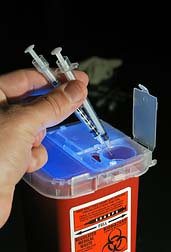 Natalie Fullerton was a little girl with a big problem, one that required a double-lung transplant at the tender age of 29 months. However, in spite of such a major surgical procedure little Natalie was recovering well. When a tube was implanted into Natalie's chest in order to deliver intravenous meds, Natalie's father Leslie Fullerton used heparin syringes from AM2PAT to clean the tube.
Natalie Fullerton was a little girl with a big problem, one that required a double-lung transplant at the tender age of 29 months. However, in spite of such a major surgical procedure little Natalie was recovering well. When a tube was implanted into Natalie's chest in order to deliver intravenous meds, Natalie's father Leslie Fullerton used heparin syringes from AM2PAT to clean the tube.According to an exhaustive investigative essay in the June 7th, 2008, issue of the Chicago Tribune, the tot took an almost immediate turn for the worse and was back in hospital within days. Four months later wee Natalie died in her mother's arms, March 12th, 2008.
The heparin syringes used by the Fullertons on Natalie were from AM2PAT, a company that has been shut down. The former head of the company is living away from his family in his native India and, according to the Chicago Tribune, attempting to avoid the potential for 95 years behind bars for his alleged role in all the wrongdoing at the AM2PAT facility.
However, the US Food and Drug Administration (FDA) has also been criticized for its handling of the situation.
According to the Tribune report, the batch of heparin syringes have been linked to four deaths and 162 illnesses in the US. The Tribune enlisted the help of medical consultant Gordon Harnack to review more than 120 pages of FDA reports with regard to the AM2PAT plant dating back to 2005.
He said inspectors didn't look deep enough, even as contamination problems at the plant became apparent. "Time after time, the evidence was there that [AM2PAT] management had little intent of complying with adequate FDA regulations," Harnack said.
According to the Tribune report, AM2PAT advanced faked documentation to the FDA in order to win approval to manufacture heparin syringes, prosecutors allege. That approval was secured in 2003, and AM2PAT began producing heparin syringes in a converted strip mall in Raleigh, North Carolina.
The first hint of trouble came in March 2005, when a pharmacist reported finding "copious" amounts of orange sediment floating in an AM2PAT heparin syringe. The same pharmacist reported finding an inch-long black hair, in another.
According to the Tribune an FDA inspector spent six days at the plant in June of that year and noted no fewer than 9 "significant" violations, some of which could have "an adverse effect on product quality."
A warning letter was sent to AM2PAT, and in January of 2006, the FDA followed up with another visit. AM2PAT had either fixed deficiencies, or promised to address major concerns.
A little more than a year later, in the spring and summer of 2007, a patient reported seeing "white, wispy" material floating in a syringe. Another patient reported seeing brown particles in another syringe from the same batch.
The FDA had in the meantime scheduled another inspection for June 26th, 2007, but upon arriving at the facility in Raleigh, the inspector found the plant closed. It had moved to another site 30 miles away in Angier. The FDA was not notified, which is a contravention of regulation and protocol.
That same summer, B. Braun Medical—a customer of AM2PAT—announced a recall July 30th of more than a million heparin syringes. An analysis of the recalled syringes showed the presence of medical-grade silicone. Such particles in heparin would be capable of causing brain damage or deadly blood clots.
Later that fall, in October of 2007, AM2PAT shipped heparin-filled syringes tainted with bacteria, according to unidentified authorities noted in the Tribune article. Various allegations accuse the company of keeping two sets of records, of switching to a "novel, non-traditional" sterilization technique (according to the FDA) and failure to adhere to the appropriate clean-room temperature during manufacturing.
READ MORE HEPARIN LEGAL NEWS
It should be noted that the FDA is under new management, if you will, with President Obama's own man at the helm and reforms are promised. However, insomuch as the AM2PAT heparin contamination was a result of the allegedly grave condition of the manufacturing facility and misrepresentations allegedly carried out by the principles of the company, the FDA has been cited for not digging deeper and not following procedure in its investigation of suspected contamination in heparin syringes, resulting in the illness or death of patients requiring heparin injection.
